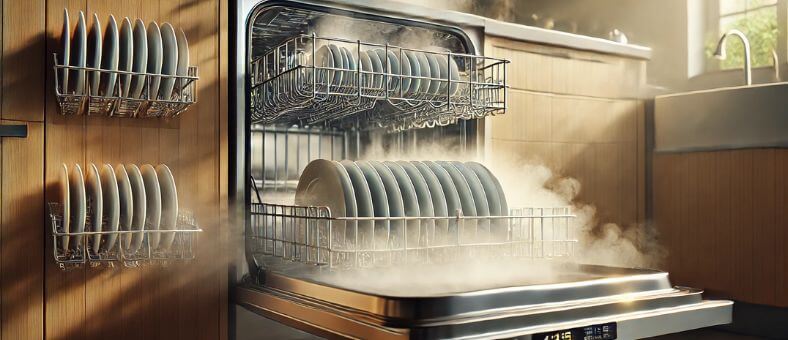A harmonious home is achieved when gadgets are in their ideal spots.. Such is the serene ambiance a dishwasher brings, neatly tucked away, awaiting its next cycle. Similar to the gentle waves on a peaceful lake, knowing how to place or replace this household gem can add tranquility to our daily chores. If the thought “How to install or replace a dishwasher” has ever crossed your mind, you’re in for a treat.
This guide is woven with simplicity, understanding your need for clarity. In a world brimming with complications, there’s something genuinely peaceful about knowing you can easily manage a household task. By the end of our journey, you will have acquired knowledge and confidence in your newly acquired skills.
Please take a seat in a comfortable chair as we begin this peaceful journey. Dive deeper into our guide, and you’ll find it’s easier than you think. Let’s empower you to make your kitchen shine even brighter. Dive in, and discover the calm amidst the chaos.
Evolution of Ease
Early dishwashers were sold as “wooden boxes” until the 1950s, when streamlined designs and advanced features began to emerge.
Table of Contents
Step-by-Step Guide: Replacing Your Dishwasher

Step 1: Assessing the Existing Dishwasher Setup
Before diving into the replacement process, assessing the dishwasher set up in your kitchen is essential. Take a close look at the current installation, including the dishwasher’s location, dimensions, and connections. This evaluation will help you understand the requirements for the new dishwasher and ensure a smooth transition during the replacement process.
Step 2: Gathering the Necessary Tools and Materials
To replace your dishwasher successfully, gather all the necessary tools and materials beforehand. This may include a screwdriver, adjustable wrench, pliers, level, measuring tape, electrical tester, and any specific hardware required for your new dishwasher. Having everything ready at the beginning will save you time and make the installation process more efficient.
Step 3: Turning Off the Power and Water Supply
Safety is paramount when working with electrical appliances. Before replacing your dishwasher, turn off the power supply at the main circuit breaker. Also, locate the water shut-off valve and turn off the water supply to prevent leaks or water damage during installation.
Step 4: Disconnecting the Electrical Cable
Once the power is turned off, carefully disconnect the electrical cable connected to the dishwasher. This usually involves unscrewing the cover plate and disconnecting the wires using wire nuts or connectors. Follow the manufacturer’s instructions and take precautions to ensure a safe disconnection.
Step 5: Shutting Off the Water Supply
Before disconnecting the water line, shut off the water supply using the shut-off valve. This valve is typically located under the sink or near the dishwasher. Turn the valve clockwise to close it and prevent water flow to the dishwasher.
Step 6: Disconnecting the Water Line
With the water supply shut off, you can now disconnect the water line connected to the dishwasher. Use pliers or an adjustable wrench to loosen the fittings and carefully detach the water line. Be prepared for any residual water in the line, and have a towel or bucket handy to catch any drips.
Step 7: Removing the Front Panel
In some cases, the dishwasher’s front panel may need to be removed to access the mounting brackets or screws. Follow the manufacturer’s instructions to detach the front panel, which may involve removing screws or clips. Take care not to damage the panel during this step.
Step 8: Detaching the Drain Line
Locate the drain line connected to the dishwasher and carefully detach it. This line is usually connected to a drain pipe under the sink. Loosen the clamp or unscrew the connection to release the drain line. Again, be prepared for residual water and have a towel or bucket to catch any spills.
Step 9: Removing Mounting Brackets or Screws
To remove the old dishwasher from its position, you may need to loosen and remove the mounting brackets or screws securing it in place. These are typically located on the top or sides of the dishwasher. Use a screwdriver or wrench to carefully remove the brackets or screws, ensuring the dishwasher is free to be moved.
Step 10: Carefully Sliding Out the Old Dishwasher
With all the connections, brackets, and screws detached, it’s time to carefully slide out the old dishwasher from its position. Make sure to support the weight of the dishwasher and take extra caution to avoid any damage to the surrounding cabinets or flooring.
Step-by-Step Guide: Installing Your Dishwasher

Step 1: Preparing for Installation
Before installing your new dishwasher:
Make sure you have all the necessary tools and materials on hand.
Clear out the space under the countertop where the dishwasher will be placed, removing any debris or obstructions.
Ensure that the electrical and plumbing connections are ready and accessible for installation.
Step 2: Positioning and Aligning the New Dishwasher
Carefully slide the new dishwasher into position, aligning it with the designated space under the countertop. Use a level to ensure the dishwasher is perfectly aligned horizontally and vertically. Adjust the dishwasher’s height, if needed, by adjusting the leveling feet.
Step 3: Connecting the Water Supply
Connect the water supply line to the dishwasher. Use a flexible hose or copper tubing to connect the dishwasher’s water inlet valve to the shut-off valve under the sink. Ensure the connection is tight and secure, and check for leaks once the water supply is turned on.
Step 4: Connecting the Drain Line
Attach the dishwasher’s drain line to the designated drain pipe or garbage disposal under the sink. Use a hose clamp or a hose connector to secure the connection, ensuring it is watertight. Double-check for any kinks or obstructions in the drain line that may hinder proper drainage.
Step 5: Leveling the Dishwasher:
Ensure the dishwasher is leveled from front to back and side to side. Use the adjustable feet to raise or lower the dishwasher as necessary. A level dishwasher will optimize its performance and prevent water pooling or leaking.
Step 6: Securing the Dishwasher in Place
Secure the dishwasher in its designated position by attaching it to the surrounding cabinets or countertop. Follow the manufacturer’s instructions for installing mounting brackets or securing screws to ensure the dishwasher is stable and firmly in place.
Step 7: Testing the Dishwasher Installation
Once the dishwasher is securely installed, turn on the water supply and check for leaks. To ensure the dishwasher is working properly, run a test cycle. Monitor the cycle for unusual noises or issues and adjust the dishwasher settings.
For a visual guide on evaluating your existing dishwasher setup, check out this video:
Caution: Electrical Safety Precautions
Turn Off the Power Supply
Before working with any electrical components of your dishwasher, turn off the power supply at the main electrical panel. This will help prevent electrical shocks or accidents during the installation or repair.
Use Proper Insulation and Wiring
Ensure that your dishwasher’s electrical wiring and connections are up to code and properly insulated. Use wiring materials and techniques professionals recommend to minimize the risk of electrical hazards.
Avoid Water Contact with Electrical Components
Keep in mind that water and electricity do not mix. Avoid water contact with electrical components when installing or working on your dishwasher. Ensure all electrical connections are dry and secure before powering on the dishwasher.
Do Not Overload the Electrical Circuit
Avoid overloading the electrical circuit that powers your dishwasher. Each dishwasher has specific electrical requirements, and exceeding these can lead to circuit overloads, tripped breakers, or even electrical fires. Consult the manufacturer’s guidelines or a professional electrician to ensure proper electrical capacity.
Hire a Professional for Electrical Work
Hiring a professional electrician is best if you need more clarification or are uncomfortable with electrical work. They have the expertise and knowledge to safely handle electrical connections and ensure your dishwasher is installed correctly and wired.
Check the GFCI Outlet for Proper Functioning
Ensure the outlet where your dishwasher is connected has Ground Fault Circuit Interrupter (GFCI) protection. Test the GFCI outlet regularly to ensure it functions correctly and provides the necessary electrical safety.
Keep Cords and Wires Away from Heat Sources
Ensure that your dishwasher’s electrical cords and wires are kept away from heat sources like the dishwasher’s heating element or other hot surfaces. This will prevent the risk of melting or damage to the electrical components.
Regularly Inspect the Power Cord for Damage
Periodically inspect the power cord of your dishwasher for any signs of wear, fraying, or damage. If you notice any issues, replacing the power cord to maintain electrical safety is important.
Avoid DIY Electrical Modifications
Avoid making DIY modifications or alterations to the electrical components of your dishwasher. A qualified professional should perform any changes to ensure compliance with electrical codes and regulations.
Follow Manufacturer’s Guidelines for Electrical Connections
Always follow the manufacturer’s guidelines and instructions regarding electrical connections for your dishwasher. They will provide specific instructions for wiring, grounding, and electrical requirements to ensure safe and proper operation.
Avoiding Common Mistakes When Installing or Replacing a Dishwasher: Expert Tips
Measure and plan properly
Before installing or replacing a dishwasher, ensure that you have accurate measurements of the space and have considered any potential obstacles or limitations.
Check the compatibility
Ensure the new dishwasher is compatible with your existing plumbing and electrical connections. Check the specifications and requirements provided by the manufacturer.
Follow the instructions
Read and follow the installation instructions provided by the manufacturer carefully. Each dishwasher may have specific requirements and steps for a successful installation.
Secure the dishwasher properly
Use the appropriate mounting brackets or screws to secure the dishwasher in place. This will prevent any unnecessary movement or vibration during operation.
Test for leaks
After the installation, thoroughly check for any water leaks. Run a cycle and monitor for any signs of water leakage from the connections or hoses.
Level the dishwasher
Ensure that the dishwasher is properly leveled to avoid any imbalance or water pooling. Use a leveling tool to adjust the feet of the dishwasher as needed.
Allow proper ventilation
Leave adequate space around the dishwasher for proper ventilation. This will help dissipate heat and prevent overheating of electrical components.
Don’t rush the process
Take your time during the installation or replacement. Rushing can lead to mistakes or oversights that may cause issues later on.
Seek professional help if needed
If you need clarification on any aspect of the installation or replacement or encounter any difficulties, feel free to seek professional help. A qualified technician or plumber can ensure a smooth and correct installation.
Silent Operators
Today’s quietest dishwashers operate at a whispery 37 decibels – that’s quieter than a soft conversation!
Creative Dishwasher Installation Ideas for Small Kitchens
Are you tired of limited space in your small kitchen? Do you wish you had more room to accommodate a dishwasher? Well, you’re in luck! With some creativity and strategic planning, you can find clever solutions to install a dishwasher even in the smallest kitchens. No more sacrificing convenience for space limitations. Let’s explore some innovative ideas that will help you make the most out of your kitchen layout while enjoying the benefits of a dishwasher.
Utilizing Vertical Space: Installing a Slimline Dishwasher
Compact and Space-Saving Design
A slimline dishwasher is designed to fit into small kitchens with limited space. Its compact dimensions allow it to be installed in narrow areas, such as between cabinets or tight corners. Despite its smaller size, a slimline dishwasher still offers ample capacity to accommodate your daily dishwashing needs. This space-saving design ensures you enjoy a dishwasher’s convenience without sacrificing valuable kitchen space.
Adjustable Racks and Shelves for Flexibility
One of the key advantages of a slimline dishwasher is its adjustable racks and shelves. These features provide flexibility in organizing your dishes and utensils. You can easily customize the interior space to accommodate various dish sizes, from small plates to large pots and pans. The adjustable racks and shelves allow you to make the most efficient use of the available space, ensuring that every item fits securely and gets thoroughly cleaned during the wash cycle.
Customizable Paneling to Blend with Kitchen Cabinets
Many slimline dishwasher models offer customizable paneling options to achieve a cohesive and seamless look in your kitchen. This means that you can choose a panel that matches your kitchen cabinets, allowing the dishwasher to blend seamlessly with the overall design of your kitchen. You create a visually appealing and harmonious kitchen environment by integrating the slimline dishwasher with the surrounding cabinetry. The customizable paneling enhances the aesthetic appeal and adds a touch of elegance and sophistication to your small kitchen.
Drawer-Style Dishwasher: Maximizing Efficiency and Functionality
Separate Compartments for Different Wash Cycles
A drawer-style dishwasher offers the advantage of having separate compartments for different wash cycles. This innovative design allows you to run multiple wash cycles simultaneously, saving time and improving overall efficiency. For example, you can wash delicate glassware in one drawer while running a heavy-duty cycle in the other. The separate compartments also prevent cross-contamination between dishes, ensuring a thorough and hygienic cleaning. With this feature, you can customize your dishwashing experience and achieve optimal results for each load.
Energy and Water Efficiency
Drawer-style dishwashers are designed with energy and water efficiency in mind. They typically have smaller capacities than traditional dishwashers, requiring less water and energy. This translates to cost savings on utility bills and a reduced environmental footprint. Additionally, drawer-style dishwashers often have adjustable racks and shelves, allowing you to maximize space utilization and wash fewer dishes when needed. By combining efficient water and energy usage with intelligent design, these dishwashers help you save resources without compromising performance.
Easy Loading and Unloading
One of the standout features of a drawer-style dishwasher is its ergonomic design which makes loading and unloading dishes a breeze. With separate drawers that slide out smoothly, you can easily access your dishes without bending down or reaching into a deep cavity. This enhances convenience and reduces the risk of back strain or injury. The drawers typically have adjustable racks and tines, allowing you to customize the layout to fit your dishes perfectly. This level of flexibility and ease of use ensures a seamless dishwashing experience. It makes the task of loading and unloading a much more enjoyable one.
Portable Dishwasher Solutions for Small Kitchens
Freestanding Design with Wheels for Mobility
A portable dishwasher offers the convenience of a freestanding design with wheels, making it highly mobile and easy to move around your kitchen as needed. This feature is especially beneficial for small kitchens where space may be limited. With the ability to effortlessly roll the dishwasher to different areas, you can optimize your kitchen layout and adapt to changing needs. Whether you need to create extra counter space or reposition the dishwasher for better accessibility, the mobility of a portable dishwasher gives you the flexibility to customize your kitchen setup.
Compact Size and Versatile Placement Options
Portable dishwashers are designed with a compact size, making them ideal for small kitchens. Despite their smaller footprint, these dishwashers can accommodate many dishes. The compact size also provides versatile placement options. Depending on your available space and preference, you can place the dishwasher on a countertop, under a cabinet, or even in a pantry. This versatility lets you make the most of every inch in your kitchen while ensuring convenient access to a dishwasher for effortless cleaning.
Quick and Easy Installation
Installing a portable dishwasher is relatively straightforward, making it a practical solution for small kitchens. These dishwashers typically come with a standard faucet adapter allowing quick and easy connection to the kitchen sink. The installation usually involves attaching the adapter to the faucet and connecting the dishwasher’s inlet and drain hoses. With minimal plumbing or modification, you can have your portable dishwasher up and running quickly. This simplicity and ease of installation make portable dishwashers an attractive option for those seeking a hassle-free solution for their small kitchen.
Hidden Dishwasher: Integrating with Kitchen Cabinetry
Custom Paneling for Seamless Appearance
A hidden dishwasher allows you to integrate it seamlessly with your kitchen cabinetry, creating a cohesive and elegant look. With custom paneling, you can match the dishwasher’s exterior to your existing cabinetry, making it virtually indistinguishable from the surrounding cabinets. This custom paneling option ensures that your dishwasher blends seamlessly with the overall design of your kitchen, enhancing its visual appeal and maintaining a cohesive aesthetic.
Concealed Controls for a Sleek Look
A hidden dishwasher often features concealed controls, adding to its sleek and streamlined appearance. With hidden or touch-sensitive buttons located on the top edge of the dishwasher door, no visible control panels disrupt the clean lines of your cabinetry. This design choice enhances the visual appeal and makes it easier to clean the dishwasher’s exterior without any obstructions. The concealed controls contribute to a minimalist and modern look, harmoniously integrating your kitchen cabinetry.
Cabinet Depth Dishwasher for Space Optimization
A hidden dishwasher is typically designed to be cabinet depth, meaning it aligns with the depth of your surrounding cabinetry. This feature allows for optimal space utilization in your kitchen. By eliminating the protrusion of a standard dishwasher, a cabinet-depth dishwasher ensures a flush and seamless fit within your cabinetry, maximizing available space. This design choice not only enhances the overall aesthetics of your kitchen but also allows for more efficient traffic flow and better utilization of countertop space.
Wall-Mounted Dishwasher: Utilizing Unused Wall Space
Space-Saving Design without Base Cabinet
A wall-mounted dishwasher offers a unique space-saving solution by utilizing unused wall space in your kitchen. Unlike traditional dishwashers that require a base cabinet, a wall-mounted dishwasher is directly mounted on the wall, eliminating the need for additional floor space. This innovative design frees up valuable floor space in your kitchen, making it ideal for smaller kitchens or areas where base cabinets are not feasible. By taking advantage of unused wall space, you can maximize the functionality of your kitchen without compromising on dishwashing convenience.
Adjustable Height for Convenient Access
One of the advantages of a wall-mounted dishwasher is its adjustable height feature. This allows you to position the dishwasher at a convenient height, ensuring easy access to load and unload dishes. The adjustable height feature is particularly beneficial for individuals with mobility issues or those who prefer a specific working height. You can easily customize the size of the dishwasher to match your ergonomic needs, providing a comfortable and efficient dishwashing experience.
Easy Installation with Wall-Mounting Kit
Installing a wall-mounted dishwasher is a relatively straightforward process, thanks to the inclusion of a wall-mounting kit. This kit typically contains all the necessary hardware and instructions to securely mount the dishwasher to the wall. The installation involves attaching the mounting brackets to the wall studs and then hanging the dishwasher on the brackets. With the provided instructions and essential tools, you can easily complete the installation without needing professional assistance. The wall-mounting kit ensures a secure and stable structure, allowing you to easily enjoy the benefits of a wall-mounted dishwasher.
Under-the-Sink Dishwasher: Clever Use of Cabinet Space
Compact Design to Fit Under Sink Area
An under-the-sink dishwasher offers a clever and space-saving solution by utilizing the cabinet space beneath your sink. Its compact design makes this dishwasher precisely engineered to fit seamlessly into the limited space under the sink area. Its slim profile and optimized dimensions allow it to slide into the cabinet, efficiently using space without sacrificing dishwashing performance. By installing an under-the-sink dishwasher, you can maximize the functionality of your kitchen while keeping the dishwasher conveniently tucked away and out of sight.
Dual-Purpose Cabinet for Storage and Dishwasher
One of the unique advantages of an under-the-sink dishwasher is its dual-purpose cabinet functionality. With this setup, the cabinet space under the sink serves as a storage area and a dishwasher compartment. The top section of the cabinet can be used for storing cleaning supplies, dishware, or other kitchen essentials. In contrast, the lower area houses the dishwasher unit. This clever design optimizes the cabinet space, allowing you to efficiently organize your kitchen items while incorporating a dishwasher. The dual-purpose cabinet setup is especially beneficial for smaller kitchens or areas with limited space, offering a practical and space-saving solution.
Final Thoughts on How to Install or Replace a Dishwasher
Wow! We’ve embarked on an exhilarating journey, mastering the step-by-step guide to installing and replacing that handy dishwasher! Who knew electrical safety could be so straightforward? And those common pitfalls? With our expert tips, they’re now easily avoidable. For our friends with snug kitchens, those creative installation ideas are game-changers!
It’s time to make the magic happen in your kitchen. Investing in a seamless installation or replacement ensures a hassle-free dishwashing experience for years to come. So, don’t wait! Dive in, give your kitchen the upgrade it deserves, and relish the convenience and efficiency that comes with it. Remember, a smooth-running kitchen starts with the right tools. And now, you’re equipped to make the best choice. Happy dishwashing!
At WashDryDazzle, our primary goal is to equip you with invaluable knowledge to simplify your day-to-day tasks; to explore more, check out our central hub of Dishwasher Guides.
Frequently Asked Questions (FAQs)
What tools do I need to set up my dishwasher?
You’ll need a screwdriver, an adjustable wrench, a level, a tape measure, and pliers to set up your dishwasher.
What plumbing things do I need for my dishwasher?
Your dishwasher needs a water supply line, a drain hose, and a spot to connect them under your sink.
How much will it cost to install a dishwasher?
The cost varies, but it can range from $100 to $200 if you hire someone. If you do it yourself, it might be cheaper!
Can I replace my old dishwasher myself?
Yes, you can! Just make sure to read the manual, gather the right tools, and follow safety steps.
How do I make sure my dishwasher doesn’t tip over?
Attach it to the countertop using screws or clips. This keeps it steady and safe.
My dishwasher door seems uneven. What do I do?
Adjust the door by turning the door hinges or checking the leveling legs at the bottom. This will help it close right.
I got a new dishwasher. How do I get rid of the old one?
Call your town’s waste service or a recycling center. They can tell you the best way to throw it away.
How do I pick the right size dishwasher for my kitchen?
Measure the space in your kitchen and check the size of the dishwashers in the store. Make sure it fits!
Why is it good to install my dishwasher the right way?
When done right, your dishwasher cleans better, runs safely, lasts longer, and can even save you money!
Start Your Dishwasher Adventure!
Have you just entered the exciting world of dishwashers or brought your first one home? Kick off your journey with our user-friendly Dishwasher Basics Guide. We simplify the key ideas and mechanics behind countertop dishwashers for you. Dive into our informative articles and begin mastering your appliance today!
- What is a Dishwasher? Everything You Need to Know
- What is a Portable Dishwasher? From Compact Convenience to Deep Cleaning
- What is a Built-in Dishwasher? Facts You Must Know!
- What Is a Smart Dishwasher? Everything You Need to Know
- What is an Integrated Dishwasher?
- How a Portable Dishwasher Works?
- How Do Counter Dishwashers Work?
- What is a Dishwasher High Loop and Why You Need One










